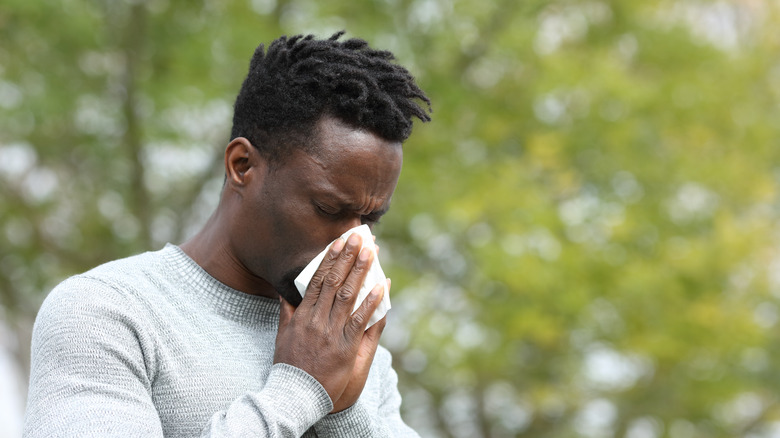Is This The Origin Of Spring Fever?
Spring has, for millennia, been a time of renewal, re-evaluation, and starting over. Ancient humans noticed that every year, the days lasted longer, the sun rose higher in the sky, the flowers bloomed, leaves re-emerged on the trees, and life resumed following months of winter. You may be compelled to engage in some spring cleaning, while baseball players are gearing up for Spring Training. Poet Alfred Lord Tennyson famously wrote that, in the spring, "a young man's fancy lightly turns to thoughts of love," and the phrase "March hare" refers to the fact that male hares, in the spring, tend to behave erratically (to human observers, that is) with their courtship rituals.
Another spring-related concept is that of spring fever: depending on the time in history (or prehistory) during which you said it, it could either mean a state of enthusiasm and giddiness, or a painful and potentially fatal malady brought on by malnutrition.
Spring fever is real, and there are physiological reasons for it
Spring fever isn't just one of those things that's been observed culturally; it's real, with real physiological causes and changes that can be measured scientifically in a laboratory. During the long winter months, we get less sunlight, due to both being indoors and due to shorter days.
In the winter, according to The Los Angeles Times, the brain produces more melatonin, a hormone that regulates sleep. When the spring comes, the eyes register sunlight, which in turn sends a signal to the brain to produce less melatonin, resulting in greater wakefulness. Similarly, around this time the brain starts producing more serotonin, a chemical that, among other things, elevates mood. This combination of the lack of a sleep-inducing chemical plus a mood-enhancing chemical results in enhanced enthusiasm, awareness, and giddiness right around this time of year.
Of course, that's the science behind the "good" kind of spring fever. Historically, there has also been a bad kind of spring fever.
There have been three versions of spring fever, historically
Humans have been reacting to spring in different ways throughout the millennia, depending on changes to our diets, habitats, and lifestyles. The Los Angeles Times explains that during prehistory, humans spent their winters in a state of "near-hibernation," according to anthropologists. In the spring, our ancestors would emerge from their dwellings and immediately set about hunting, gathering, and, shall we say, creating more humans. The modern version of this illness presents a bit differently, but is the result of the same biological mechanisms: we may find ourselves a bit happier, a bit more enthusiastic, perhaps restless from having spent months largely cooped up inside during the winter months.
A few centuries ago, however, there was a third kind of spring fever, and there was nothing fun about it. As Knox Pediatrics explains, in the 1700s and 1800s, "Spring Disease" involved fatigue, hemorrhaging gums, bone pain, and other severe maladies. Fortunately, there was an easy cure; unfortunately, it wasn't always readily available to the people who needed it.
Spring fever was potentially deadly at one time
A perfect storm, of sorts, coalesced in the 1700s that led to a disease that observers of the time called "spring fever" or "spring disease," and there was nothing pleasant about it. As Knox Pediatrics explains, the disease was particularly evident in urban dwellers, and it involved, among other symptoms, bleeding gums, easy bruising, and bone pain. Before the discovery of a cure, thousands died from it each year.
So what caused the deadly spring fever of a couple of centuries ago? Malnutrition, basically. Doctors at the time noticed that the disease struck people who had gone the previous few months without fruits and vegetables, according to The Los Angeles Times. The problem was particularly noticeable in people who lived in cities; people who lived on farms had better access to those foodstuffs, while those in the cities did not.
As it turns out, there was (and is) an almost-instant cure for the deadly version of spring fever. That's because the disease was almost certainly the same disease that bedeviled sailors on long sea voyages, almost certainly without fresh fruits and vegetables. And the sea-farers' disease also has a miracle cure.
spring fever was almost certainly scurvy
You may have watched a movie in which a pirate calls another pirate a "scurvy dog" or some similar insult. There's a reason for that: pirates and legitimate sailors were both, for centuries, bedeviled by an illness that derived from their limited diets. Scurvy, according to Medical News Today, was (is) caused by a deficiency in Vitamin C, and it claimed the lives of more than one sea-farer in its time. On the ground, it manifested itself as "spring disease," according to The Los Angeles Times, for basically the same reason -– going months without fresh fruit and vegetables.
The best way to treat somebody suffering from a Vitamin C deficiency (or to prevent a Vitamin C deficiency in the first place) is to provide them with the missing nutrient. In the 1700s, according to Knox Pediatrics, Scottish physician Dr. James Lind figured out that the addition of citrus fruits to the diet at once cured and prevented scurvy, and soon enough, limes were part of the diet of British sailors, giving rise to the nickname "Limeys" for the British. Eventually, the cure made its way to cities, and "land scurvy," as it was sometimes called, also became a thing of the past.
Other diseases peak in spring
The bad kind of spring fever is now a thing of the past, but that doesn't mean that spring doesn't bring with it a host of other medical maladies. For example, it goes without saying that allergy-related complaints peak in the spring, according to The Los Angeles Times. But did you know that, for reasons no one has quite figured out yet, dermatologists' offices are filled in the spring with patients suffering from rosacea and dermatitis? Another "disease" that peaks in spring, says the obstetrics community, is unplanned pregnancy. Suicide also peaks in spring, for reasons that the mental health community has yet to explain.
Other medical ailments tend to go by the wayside during the spring, however. Heart attacks peak in the winter, for example, as does seasonal flu. Rates of STIs also decrease in the spring, due to people having less sex with each other, a state of affairs The LA Times notes is "paradoxical."





